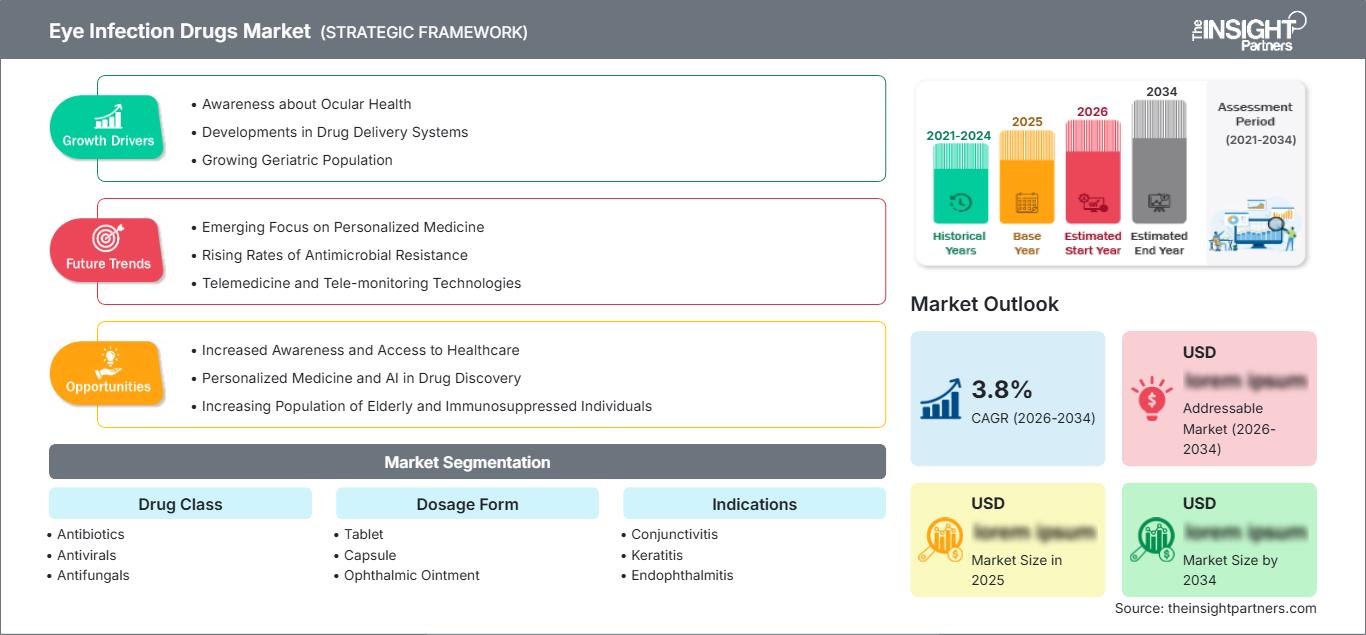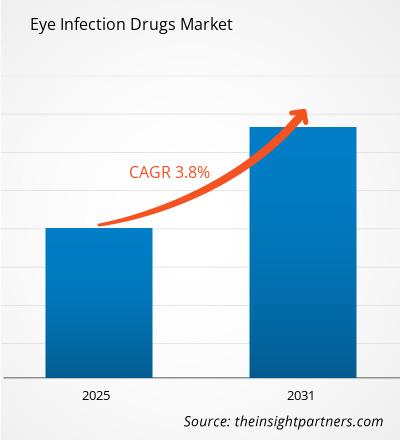Se prevé que el mercado de medicamentos para infecciones oculares crezca a una tasa compuesta anual compuesta del 3,8% entre 2026 y 2034. Las condiciones del mercado siguen evolucionando, lo que abre nuevas oportunidades para los interesados. El panorama general refleja un progreso estable y un potencial de crecimiento a largo plazo.
El informe del mercado de medicamentos para infecciones oculares se segmenta por clase de fármacos en antibióticos, antivirales, antifúngicos, antihistamínicos, corticosteroides y glucocorticoides. El segmento de formas de dosificación incluye comprimidos, cápsulas, ungüentos oftalmológicos y colirios. Los segmentos de indicaciones incluyen conjuntivitis, queratitis, endoftalmitis, blefaritis, orzuela o orzuelo, uveítis, celulitis y herpes ocular. El segmento de agentes causantes incluye virus, bacterias, hongos y alérgenos. La evaluación del mercado se presenta en dólares estadounidenses para el análisis segmental anterior. El análisis global se desglosa a nivel regional y a los principales países. La evaluación del mercado se presenta en dólares estadounidenses para el análisis segmental anterior.
Propósito del informe
El informe Mercado de Medicamentos para Infecciones Oculares de The Insight Partners pretende describir el panorama actual y el crecimiento futuro, los principales factores impulsores, los retos y las oportunidades. Esto proporcionará información a diversos actores empresariales, como:
- Proveedores de tecnología/fabricantes: Para comprender la dinámica cambiante del mercado y conocer las posibles oportunidades de crecimiento, permitiéndoles tomar decisiones estratégicas informadas.
- Inversores: Realizar un análisis exhaustivo de tendencias sobre la tasa de crecimiento del mercado, las proyecciones financieras y las oportunidades que existen a lo largo de la cadena de valor.
- Organismos reguladores: Regular las políticas y vigilar las actividades en el mercado con el objetivo de minimizar el abuso, preservar la confianza y la confianza de los inversores, y mantener la integridad y estabilidad del mercado.
Infecciones oculares Segmentación del mercado Segmentación del mercado Clase de medicamentos
- Antibióticos
- Antivirales
- Antivirales
- Antihistamínicos
- Corticosteroides
- Glucocorticoides
Forma dosificada
- Cápsula
- de comprimido Pomada oftálmica
- Gotas para
los ojos Indicaciones
- conjuntivitis
- Keratitis
- Endoftalmitis
- Blefaritis
- Uveítis
- Celulitis
- , herpes ocular
, agentes
- causantes, virus
- bacterias,
- hongos, alérgenos
Disfrutará de la personalización gratuita de cualquier informe, incluyendo partes del mismo, análisis por país y un paquete de datos de Excel. Además, podrá aprovechar excelentes ofertas y descuentos para startups y universidades.
Mercado de medicamentos para infecciones oculares: Perspectivas estratégicas

-
Obtenga las principales tendencias clave del mercado de este informe.Esta muestra GRATUITA incluye análisis de datos, desde tendencias del mercado hasta estimaciones y pronósticos.
Impulsores del crecimiento del mercado de medicamentos para infecciones oculares
- Concienciación sobre la salud ocular: La creciente concienciación sobre la salud ocular y la necesidad de lograr un diagnóstico y tratamiento tempranos para obtener mejores resultados está contribuyendo a la demanda de medicamentos para infecciones oculares.
- Avances en los sistemas de administración de medicamentos: Los avances en los sistemas de administración de medicamentos (ungüentos tópicos, gotas para los ojos y medicamentos administrados por vía oral) están ayudando a que el tratamiento sea más efectivo y a mejorar el cumplimiento del paciente.
- Crecimiento de la población geriátrica: La creciente población geriátrica, junto con la creciente incidencia de enfermedades oculares degenerativas, está creando una demanda extremadamente alta de medicamentos para infecciones oculares.
Tendencias futuras del mercado de medicamentos para infecciones oculares
- Enfoque emergente en la medicina personalizada: Existe un enfoque emergente en la medicina personalizada, lo que permite brindar un tratamiento personalizado basado en las características individuales del paciente, lo que conducirá a terapias más efectivas y personalizadas.
- Aumento de la resistencia a los antimicrobianos: El aumento de la resistencia a los antimicrobianos impulsará la aparición de nuevos antibióticos y nuevas opciones de tratamiento para las infecciones oculares.
- Tecnologías de telemedicina y telemonitorización: La mayor implementación de las tecnologías de telemedicina y telemonitorización aumentará el acceso a la atención médica en regiones desatendidas, mejorando el diagnóstico y el tratamiento tempranos de las infecciones oculares.
Oportunidades de mercado de medicamentos para infecciones oculares
- Mayor conciencia y acceso a la atención médica: La creciente conciencia sobre el cuidado ocular y un mejor acceso a los servicios de atención médica en los países en desarrollo están impulsando la demanda de tratamientos para infecciones oculares.
- Medicina personalizada e IA en el descubrimiento de fármacos: El potencial de la medicina personalizada y el uso de la inteligencia artificial en el descubrimiento y desarrollo de fármacos ofrecen una promesa significativa para el crecimiento y la innovación futuros en el mercado de medicamentos para infecciones oculares.
- Aumento de la población de personas mayores e inmunodeprimidas: El aumento de la población de personas mayores e inmunodeprimidas genera una demanda significativa de tratamientos efectivos contra las infecciones oculares, lo que impulsa el crecimiento del mercado.
Mercado de medicamentos para infecciones oculares
Los analistas de The Insight Partners han explicado detalladamente las tendencias regionales y los factores que influyen en el mercado de medicamentos para infecciones oculares durante el período de pronóstico. Esta sección también analiza los segmentos y la geografía del mercado de gestión de enfermedades del ritmo cardíaco en América del Norte, Europa, Asia Pacífico, Oriente Medio y África, y América del Sur y Central.
Alcance del informe de mercado de medicamentos para infecciones oculares
| Atributo del informe | Detalles |
|---|---|
| Tamaño del mercado en 2025 | US$ XX Million |
| Tamaño del mercado por 2034 | US$ XX Million |
| CAGR global (2026 - 2034) | 3.8% |
| Datos históricos | 2021-2024 |
| Período de pronóstico | 2026-2034 |
| Segmentos cubiertos |
By Clase de fármaco
|
| Regiones y países cubiertos |
Norteamérica
|
| Líderes del mercado y perfiles de empresas clave |
|
Densidad de actores del mercado de medicamentos para infecciones oculares: comprensión de su impacto en la dinámica empresarial
El mercado de medicamentos para infecciones oculares está creciendo rápidamente, impulsado por la creciente demanda del usuario final debido a factores como la evolución de las preferencias de los consumidores, los avances tecnológicos y un mayor conocimiento de los beneficios del producto. A medida que aumenta la demanda, las empresas amplían su oferta, innovan para satisfacer las necesidades de los consumidores y aprovechan las tendencias emergentes, lo que impulsa aún más el crecimiento del mercado.

- Conseguir el Mercado de medicamentos para infecciones oculares Resumen de las principales jugadoras clave
Puntos Clave de Venta
- Cobertura Integral: El informe abarca el análisis exhaustivo de productos, servicios, tipos y usuarios finales del mercado de medicamentos para infecciones oculares, ofreciendo un panorama holístico.
- Análisis de Expertos: El informe se elabora con base en el profundo conocimiento de expertos y analistas de la industria.
- Información Actualizada: El informe garantiza relevancia para el negocio gracias a su cobertura de información y tendencias de datos recientes.
- Opciones de Personalización: Este informe se puede personalizar para satisfacer las necesidades específicas del cliente y adaptarse a las estrategias comerciales.
Por lo tanto, el informe de investigación sobre el mercado de medicamentos para infecciones oculares puede ayudar a liderar el camino para decodificar y comprender el escenario de la industria y las perspectivas de crecimiento. Si bien puede haber algunas preocupaciones válidas, las ventajas generales de este informe tienden a superar las desventajas.
- Análisis histórico (2 años), año base, pronóstico (7 años) con CAGR
- Análisis PEST y FODA
- Tamaño del mercado, valor/volumen: global, regional y nacional
- Industria y panorama competitivo
- Conjunto de datos de Excel
Informes recientes
Informes relacionados
Testimonios
Razón para comprar
- Toma de decisiones informada
- Comprensión de la dinámica del mercado
- Análisis competitivo
- Información sobre clientes
- Pronósticos del mercado
- Mitigación de riesgos
- Planificación estratégica
- Justificación de la inversión
- Identificación de mercados emergentes
- Mejora de las estrategias de marketing
- Impulso de la eficiencia operativa
- Alineación con las tendencias regulatorias






















 Obtenga una muestra gratuita para - Mercado de medicamentos para infecciones oculares
Obtenga una muestra gratuita para - Mercado de medicamentos para infecciones oculares